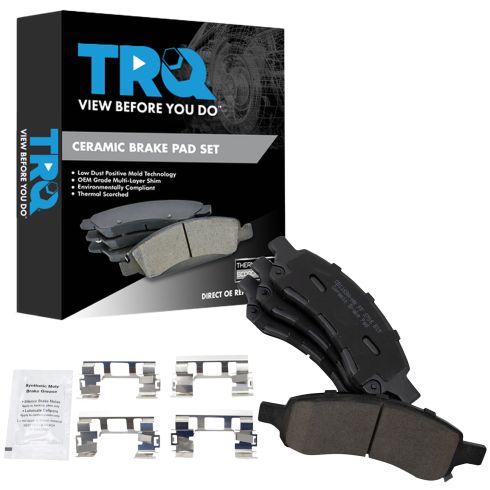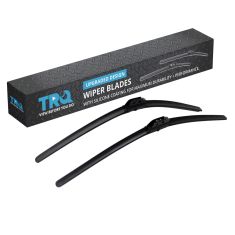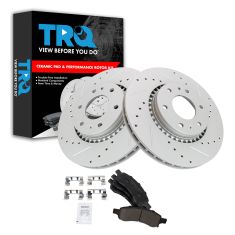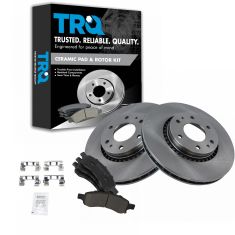Replaces
2006 GMC Envoy XL Front Ceramic Brake Pads TRQ BFA73341






BFA73341
This part doesn’t fit a . Select from parts that fit.
Specify your vehicle's year, make and model to guarantee fit.
This part doesn't fit a . Select from parts that fit.
Buy in the next and
Get it by: Saturday, Nov 15 with expedited shipping
Recommended for your 2006 GMC Envoy XL
Part Details
- 0.63 in
- 16 mm
- 0.59 in
- 15 mm
- Yes
- Bonded
- Yes
- No
- Yes
- 2.28 in
- 58 mm
- Contact Point Grease
- Hardware
- 7.01 in
- 178 mm
- Yes
- 4
- N
- Premium Posi
- Ceramic
- Mechanical
- Ceramic
- Black
- Black
- 15 mm
- 0.59 in
- Yes
- Yes
- No
- 7.01 in
- 178 mm
- Yes
- Yes
- 0.63 in
- 16 mm
- Steel
- 58 mm
- 2.28 in
- R-S-R
- No
- Yes
- Standard Replacement
Specifications
- Front
About TRQ:
TRQ is a trusted brand dedicated to making every repair a success story by combining premium parts with easy installation. Each TRQ part is engineered by a team of automotive experts to meet or exceed OEM standards, delivering enhanced performance and maximum longevity. With rigorous in-house testing, the brand ensures superior fit and function across every product line. TRQ also provides customers with best-in-class, step-by-step installation videos—so you can complete repairs with confidence, whether you're a first-time DIYer or an industry professional.
Product Features
TRQ brake pads are manufactured using premium raw materials and design standards to restore original performance. TRQ brake pads are positive molded and utilize a multi-layer shim for enhanced performance and service life. TRQ’s combination of materials and design ensures a low dust and low noise braking experience. TRQ recommends replacing your brake rotors when you replace your brake pads to ensure even wear of components and improved braking comfort. All products are fit and road-tested in our Massachusetts R&D facility to ensure we deliver on our promise of Trusted Reliable Quality.
Attention California Customers:
![]() WARNING: This product can expose you to chemicals including Lead and Lead Compounds, which are known to the State of California to cause cancer, and birth defects or other reproductive harm. For more information, go to www.P65Warnings.ca.gov.
WARNING: This product can expose you to chemicals including Lead and Lead Compounds, which are known to the State of California to cause cancer, and birth defects or other reproductive harm. For more information, go to www.P65Warnings.ca.gov.
Lifetime Warranty
This item is backed by our limited lifetime warranty. In the event that this item should fail due to manufacturing defects during intended use, we will replace the part free of charge. This warranty covers the cost of the part only.
FREE Shipping is standard on orders shipped to the lower 48 States (Contiguous United States). Standard shipping charges apply to Hawaii and Alaska.
Shipping is not available to a P.O. Box, APO/FPO/DPO addresses, US Territories, or Canada for this item.
Expedited is available on checkout to the United States, excluding Alaska, Hawaii.
Final shipping costs are available at checkout.



Created on:
Tools used
- Remove hub cap or center cap if you have it. While your car is still on the ground, use your 19mm socket to loosen your lug nuts. Jack up and secure your car with jack stands. Remove the lug nuts with your 19mm socket and ratchet. Remove the wheel and set aside.
- Use a screwdriver to force the pistons back in. Remove the two 14mm bolts to remove the calipers. Use a wire tie to fasten the caliper out of the way. Use your screwdriver to pry out your brake pads. Remove the two 18mm bolts on the caliper bracket to remove it. Remove the caliper bolt sleeves. Check their condition and clean them with a wire brush if necessary. Pull off the brake rotor. Screw in the two 10M bolts to remove the rotor. Take care not to damage the lug studs.
- Clean new rotor with brake cleaner. Insert your new pads into the brackets. Put your caliper bracket back on, and tighten the bolts to 90-100 ft lbs. Compress the caliper piston with a c-clamp to reset the pistons. Mount the caliper on the bracket and torque the bolts in to 15-20 ft lbs.
- Make sure to use a star pattern when putting your wheel lugs back on. Tighten to 100 ft lbs. Replace hubcap/center cap.
- Before driving the car again, start it up and pump the brakes a few times to get the pistons in the brakes in place. Test the brakes in your driveway before taking the car onto the road. Set your rotors by evenly braking from 30mph to 10mph, 50mph-30mph and finally 70mph to 40mph. This is best done on a straight back road without any traffic.
Brought to you by 1AAuto.com, your source for quality replacement parts and the best service on the internet.
Hi, I'm Mike Green. I'm one of the owners of 1A Auto. I want to help you save time and money repairing and maintaining your vehicle. I'm going to use my 20+ years' experience restoring and repairing cars and trucks like this to show you the correct way to install parts from 1AAuto.com. The right parts installed correctly, that's going to save you time and money. Thank you and enjoy the video.
In this video we're going to show you how to change the rear brakes on this 2004 Trailblazer same as most '02 to '09 GM mid-size SUV; the Trailblazer, Envoy, Bravada, Ranier, Saab 97x as well as the Isuzu Ascender. Tools you'll need: various size millimeter sockets with a ratchet, you'll want a breaker bar or a pipe for some extra leverage, two M10 x 7cm bolts, jack and jack stands, flat blade screwdriver, and a large C-Clamp, as well as a wire brush.
Rear tire, lug nuts are 19mm. If you don't have air tools you want to start with the vehicle on the ground, loosen the lug nuts, raise it, support it with jack stands, and then remove the lug nuts. I'll fast forward here as I remove the rest of the lug nuts and remove the wheel.
To check the condition of your brakes what you want to do is look right into this access hole and I'm going to turn the rotor a little bit so you can see the rotor. Right next to the rotor you can see the pad and it has a small hole there and even on the other side is a small hole. That hole is actually your wear indicator and since you can still see the hole that means that the pads actually have some more wear left probably on this vehicle another five or ten thousand miles. And then you also want to check the condition of your rotors, and you just want to run the back of your finger up and down just make sure that there's no deep grooves or anything in the rotors and even though these rotors look a little bit rusty it's just because the car hasn't been used a lot.
One thing we're going to do is take a large screwdriver and just carefully pry out on our caliper. That just gives us a little room to get it off and then the caliper is held on by two 14mm bolts, one down low and then one right up high. We'll fast forward through loosening and removing those bolts. They should come out pretty easy because you only tighten them up to about 15 to 20 foot pounds. Now the caliper comes right off, and you can use your screwdriver to pry out the pads.
Now to remove your rotors you're going to have to remove this bracket and there's two bolts; one here and one here. These bolts are 18mm. Always good if you're doing your own work to have a little piece of pipe around if you don't have a breaker bar because you're going to want to put your ratchet on here. These bolts are usually tightened to anywhere from 90 to 100 foot pounds. Just put your pipe on the wrench and then just go slow and easy apply pressure and loosen up the bolt. Now our other bolt, the sway bar is kind of in the way so what I'm going to do is take the 18mm wrench and then I'm going to hook my 17mm or just another wrench on here put them together like that. This gives me some extra leverage again. And again, pull nice and easy and slow and you'll break it free.
We'll speed it up here again as I use the wrench and the ratchet to remove those two 18mm bolts the rest of the way. That bracket comes off. Now if you're lucky pull your brake rotor right off. I'm not quite that lucky. I have two I believe these are either M10 or M12 bolts. Thread them right in. 17 mm heads. That will just help you get it out some, and that comes right off. So you might notice I've got a nice new backing plate and a new wheel stud on here. You can check out our other videos to see how I did those. The new disc from 1AAuto fits right on nicely. Now you'll want to reinstall your bracket. The bolt goes through and into the back of the axle. So, I've got my bolts preliminarily tightened. I'm going to use a torque wrench to tighten them to 90 foot pounds.
Before you go to put the brake pads on you want to make sure of a couple of things. These should slide back and forth nice and easily, nice and free. If they don't you can actually just pull them right out, clean them up and grease them and make sure that they move freely. Then these slides just kind of pull off and you want to take a wire brush and clean them out. So I've cleaned up this one and you don't have to get them perfect just get them cleaned out a little bit. Press them back into place, and now the new pads from 1AAuto, push them down in. They push into place. Same thing with the rear one here, push it down in. Push it in place.
So now if you go to put the caliper on you're going to find it doesn't fit, and that's because this piston has worked its way out as the pads wear. Just take an old pad put it right down, a nice big C-Clamp here. I'm going to use this C-Clamp to slowly push the piston back in. Make sure you work this gasket in, and now your caliper quite easily works down onto the new shoes, bolts in. Just going to fast forward as I just put those bolts in and preliminarily tighten them. You may find when you're tightening them you want an adjustable wrench or this looks like probably about a 15mm and you can just hold on to this nut right here. Mine seem to be going together pretty easily, and now we're going to torque those bolts to 20 foot pounds.
Now we are going to fast forward as we put the tire back on then start each one of the lug nuts by hand. You do want to make sure that you don't cross thread them, and then using our air wrench just preliminarily tighten the lug nuts. And now with the vehicle on the ground, torque the lug nuts to 100 foot pounds each, and please stay tuned to the very important last step which is to pump your brakes up before you try and road test your vehicle. And last but not least, you want to pump your brakes a bunch of times until you feel your pedal firm back up before you road test your vehicle and you can then just try and make sure you do a stop at five and ten miles an hour before going out on the road.
We hope this helps you out. Brought to you by www.1AAuto.com-- your source for quality replacement parts and the best service on the internet. Please feel free to call us toll free, 888-844-3393. We're the company that's here for you on the internet and in person.
Tools used
- Loosen the 22mm lug nuts with the vehicle on the ground Raise the vehicle with a floor jack Secure the vehicle on jack stands Remove the lug nuts Pull off the wheel
- Hold the wheel studs with a pry bar Remove the T30 screw in the rotor Loosen the 14mm bolts from the brake caliper Remove the 14mm bolts from the brake caliper Pull the caliper aside and hang it out of the way with a bungee cord Pry the brake pads off with a flat blade screwdriver Loosen the 21mm caliper bracket bolts Remove the 21mm caliper bracket bolts Pull off the brake caliper bracket Remove the brake pads Pull the rotor off If the rotor will not come off, thread the lug nuts and strike the hub area of the rotor with the ball end of a ball peen hammer Remove the cap from the old rotor
- Apply anti-seize fluid or white grease to the slides Push the slides on with a flat blade screwdriver Clean the brake pad shims with a wire brush Clean the caliper bracket with a wire brush Apply grease to the shim area on the bracket Clean the hub with a wire brush Apply grease to the hub Put the rotor on backwards Clean the rotor with brake parts cleaner
- Clean the front of the rotor with brake parts cleaner Slide the rotor on Tighten the T30 Torx screw to the rotor Adjust the e-brake until it will no longer turn Set the rotor so that the e-brake lightly drags against the rotor Press the cap onto the rotor
- Put the caliper bracket back into place Start the 21mm bolts by hand Tighten the bolts to 129 foot-pounds of torque Install the new brake pads into the bracket Apply grease to the brake pads Compress the caliper piston with a C-clamp Put the caliper on Thread the 14mm bolts by hand Tighten the bolts to 20 foot-pounds
- Slide the wheel into place Start the lug nuts by hand Tighten the lug nuts preliminarily Lower the vehicle to the ground Tighten the lug nuts to 140 foot-pounds in a triangle pattern Reattach the center cap
Hi, I'm Mike from 1AAuto. We've been selling auto parts for over 30 years! We're dedicated to delivering quality auto parts, expert customer service, and fast and free shipping, all backed by our 100% satisfaction guarantee. We've created thousands of videos to help you install our parts with confidence. That saves you time and money, so visit us at 1AAuto.com, your trusted source for quality auto parts.
In this video we're going to be working with our 2012 GMC Acadia all-wheel drive. We're going to show you how to remove and replace your rear brake pads and rotors, as well as how to adjust your e-brake up once you've installed new rotors onto the vehicle.
If you like this video, please click subscribe. We have a ton more information on this and many other vehicles. If you need these parts for your vehicle, you can follow the link down in the description over to 1AAuto.com.
Any time you work on your brakes, we suggest you wear a dust mask and glasses to keep all the dust and debris from getting into your eyes and lungs while you're working.
While we're doing this on the passenger side, this process will be the same on the driver side. We always recommend that you replace your brakes in pairs.
Here are the items you'll need for this repair: 13-22mm socket, wrenches, ratchet, socket extension, breaker bar, pry bar, torque wrench, T30 Torx bit, flat head screwdriver, hammer, wire brush, groovelock pliers, brake cleaner, grease, bungee chord
Loosen your lug nuts using a twenty-two millimeter deep socket and a breaker bar. Raise and support your vehicle. You can do this with a jack and jack stands at home, but we're going to put it up on a lift to make it easier to show. Once you have your vehicle in the air, you can finish removing your lug nuts. Remove the wheel and tire.
Hold the wheel studs with a small pry bar. Use a T30 Torx bit and a ratchet to remove your rotor screw. Once you've broken it loose, you can remove the pry bar and finish taking the screw out. Remove the two fourteen millimeter caliper bolts on the back side of the caliper with a fourteen millimeter socket and ratchet. You may have to hold the caliper pin with a seventeen millimeter wrench to keep it from turning while we loosen the fourteen millimeter bolt on the back with our socket and ratchet. Be sure to crack both of these loose before removing either one fully. Remove your caliper. Secure it up and out of the way with mechanics wire, a zip tie or a bungee cord.
Remove your old brake pads. Sometimes these can be in there a little tight, so you may need a small screwdriver to help get them out. Remove the two caliper bracket bolts with a twenty-one millimeter socket and breaker bar. Again, you'll want to loosen both of these before removing either one fully. Once you've broken the bolts lose, you can finish removing them with a twenty-one millimeter socket and ratchet. Once the bolts are out, remove your caliper carrier from the vehicle.
Sometimes you can simply pull the rotor off by hand, but ours is stuck, so we're going to hit the surface of the rotor with a hammer back and forth to release it from the hub. We never recommend that you reuse rotors when doing a brake job, because they build up grooves and rust on them. You can get them machined, but usually they are so thin after the machining process that they're much more prone to warping. If you do have to reuse your rotors, you can hit this surface to release it. Just be careful not to hit the studs.
Once you've freed it, remove the rotor. Before throwing out our old rotor, we'll have to make sure we save this little rubber cap for the access hole to adjust our e-brake in case our new rotor needs it. There are a couple of quick things you need to do to your caliper carrier before re-installing it on the vehicle. Check and make sure your slides move nice and smooth. Ours are good.
We'll have to hold back on our boot here so we can remove the slide. Take a paper towel or a clean rag and wipe all that old grease off. Then put a nice fresh coat of brake grease. Make sure we keep moisture and corrosion out and allow our brake caliper to move smooth.
Reinstall it until it pops back into the boot. Repeat this step with the opposite pin. We'll also have to remove our shims here. Now if these are all corroded or cracked and broken, you'll have to change them out with new ones, but ours look pretty good. We'll just go ahead and take a steel wire brush and remove all that corrosion from them. These don't have to be perfect as long as they're nice and smooth and clear of dirt and debris and any kind of burs or cracking. Whenever you're doing stuff like this with your brakes, you're going to want to wear a dust mask and glasses to keep all that debris that's getting kicked up out of your eyes and your lungs.
Once our slide is nice and clean, we'll do the same thing to remove any build up from where the slides ride in the caliper carrier. Once that's all clear, we'll reinstall our slide. Apply a thin coat of grease to the portion that our pads are going to ride on. Once that's all done, we'll repeat this step with the opposite shim.
This hub isn't too bad, but just because we have it off, we're going to take our steel wire brush and remove any corrosion and rust build up that's on here so we can apply a thin layer of grease to it and make it that much easier to remove our rotor the next time we have to service our brakes.
Install your rotor onto the hub backwards, and spray down the surface with brake cleaner to remove the cosmoline that they put onto the surface to keep it from rusting while it's in storage. Flip it over. Be sure to line up the beveled hole with the threads for our rotor screw. Then spray down the front surface as well.
Your rotor screw is in a critical part of the function of your rear brakes, but, as you can see, our rotors hang at kind of an angle here. That's going to make it more difficult to line up our caliper carrier, brake pads and caliper later on. If you have yours, go ahead and take that T30 Torx socket and ratchet. Tighten them in there. To adjust the e-brake in the rear, you want it to drag lightly against the inside surface of the rotor.
Locate your adjuster wheel through this access hole in the rotor. In this vehicle, it's at about eleven o'clock. Adjust up that e-brake until it won't turn anymore. Once you have it adjusted all the way out so you can't turn anymore, you want to back that adjuster back off and set it so it just lightly drags against the inside of the rotor. You've adjusted it down so that e-brake just drags lightly against the rotor.
Go ahead and reinstall your plug. Reinstall your caliper carrier and your two 21mm bolts. Tighten those down with your 21mm socket and ratchet. Torque the caliper carrier bolts to 129 foot-pounds. Install your new pads into the slides. Apply a coat of grease to the back of the pad.
Using a pair of groove drop pliers, c-clamps or proper brake caliper compressing tools, slowly collapse the piston back into the caliper until it's flush. Once the piston is pushed back into the caliper, remove whatever you used to secure it out of the way. Make sure that your flexible brake hose isn't twisted or kinked in anyway, and reinstall the caliper onto the carrier. Then you can start your two 14mm bolts by hand. Torque the bolts to 20 foot-pounds. Again, you may need to use your 17mm wrench to counter hold the guide pins from sliding.
Reinstall your wheel and tire onto the vehicle, and install your lug nuts as tight as you can by hand. Torque your wheels to 140 foot-pounds. On a six lug wheel, you want to tighten the lug nuts in a triangle, so we'll go this way across the wheel and then make another triangle to tighten it all down.
Thanks for watching. Visit us at 1AAuto.com for quality auto parts, fast and free shipping, and the best customer service in the industry.

BFA73341
877-844-3393
Monday - Friday 8:00am - 9:30pm ET
Saturday - Sunday 8:00am - 4:30pm ET
Specify your vehicle's year, make and model to guarantee fit.
This part doesn't fit a . Select from parts that fit.











